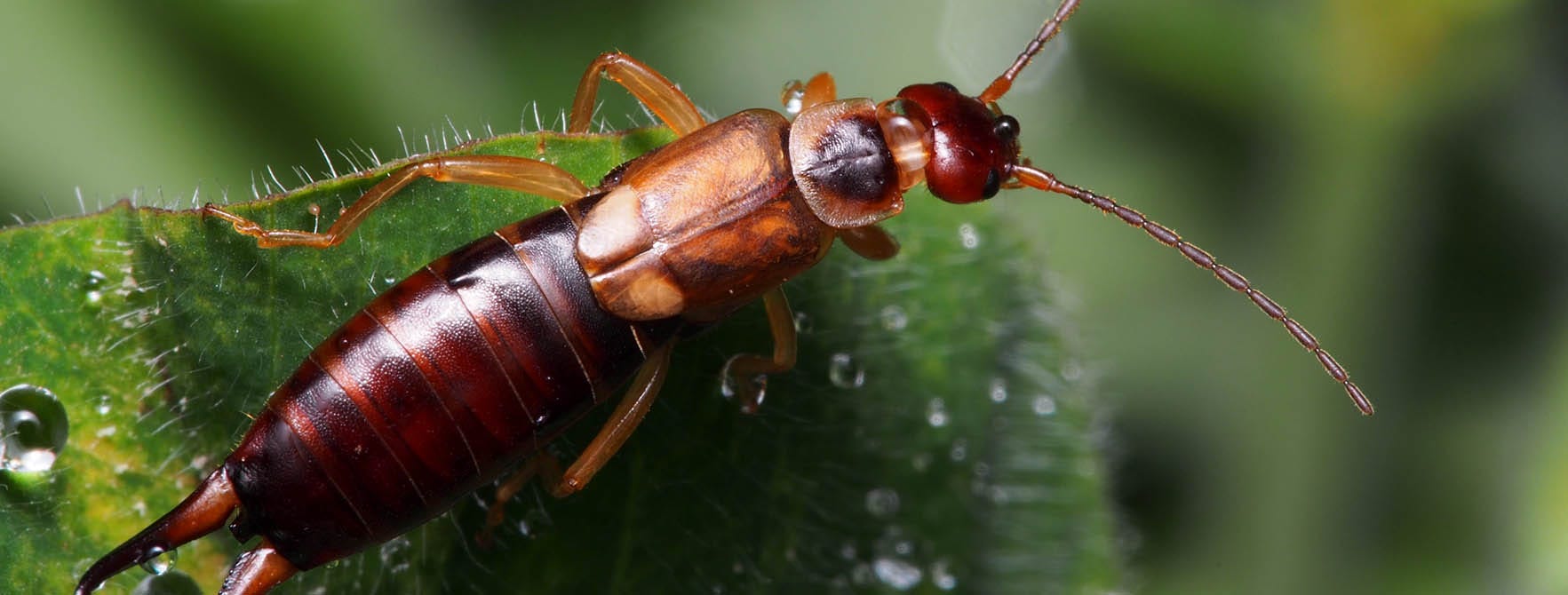advice/insect-library/crawling-insects/all-about-earwigs

So... What's an Earwig?
Adult earwigs have long slender bodies that are reddish-brown to black in color. The pincers at the end of their bodies are longer in males than in females. These pincers are probably one of the best ways to identify earwigs.
Their bodies are flat which makes it easy for them to get in and out of tight spots. Adults can be foul-smelling and may release a yellowish-brown secretion from their scent glands.
Young earwigs have shorter bodies, a lighter greenish or whitish color, and do not have wings. Eggs are cream colored and roundish in shape.
Reproduction Patterns of Earwigs
In the spring, the adult female earwig deposits about 50 eggs in a cavity in the soil. The female has been known to lay up to 300 eggs at one time in clusters in several cavities.
She will fiercely protect her eggs, and will protect her babies after they hatch until they have gone through their first molt. Then these nymphs embark on their own.
After going through several instars, they become adults. Both adults and eggs overwinter in the soil, and there is usually just one generation per year.
Earwig's Habitat

Earwigs prefer to live outside, although they may be brought inside accidentally through bags, newspapers, cut flowers, and other means. They may also enter a home on their own through a crack, especially during hot, dry weather, searching for refuge in cool basements and crawl spaces.
Earwigs scurry around at night, searching for other insects or plants on which to feed. They are often attracted to lights and can be found in large groups at night under bright outdoor lights.
During daytime hours, they prefer to hide under trash, under boards, in mulch, and just about any concealed place that is cool and moist.
They do not reproduce indoors, preferring instead to lay their eggs deep in the soil. Using a product such as Safer® Brand Ant and Crawling Insect Killer can help you eliminate your earwig problem. Since diatomaceous earth is a mechanical killer, insects cannot develop an immunity to diatomaceous earth. Click on the above link to view the product page where you can find application tips.
Earwig Controls
What?
Use Safer® Brand Ant and Crawling Insect Killer to control earwigs (and many other insects).
How?
Safer® Brand Ant and Crawling Insect Killer can harness the power of Diatomaceous Earth (DE). Diatomaceous Earth is a dust-like product that contains the crushed fossilized remains of diatoms. The dust is ingested by the earwig and affects the cuticle of the earwig, resulting in its dehydration.
The best part about Safer® Brand Ant and Crawling Insect Killer is that insects cannot develop a resistance to it. This insect killer contains no chemicals to which they can build up an immunity. Since diatomaceous earth works by dehydrating the insect, if the area where the Safer® Brand Ant and Crawling Insect Killer is applied becomes wet, it will need to be reapplied.
When?
Safer® Brand Ant and Crawling Insect Killer should be applied as soon as earwigs are discovered.
Spray Insect Killing Soap as a contact killer. Use in accordance with directions on the product label.
Natural Predators
What?
Birds are natural predators of earwigs, and since birds cannot smell, they probably don't mind the foul odor of the earwigs. Toads may also find earwigs to be a tasty delicacy.
How?
Attract birds by placing bird feeders around your property, especially near gardens and landscaping. Toads may be attracted to gardens with shrubbery and other plantings that allow for hiding places with lots of insects.
When?
Bird feeders can be placed outside at any time since birds appreciate food during the hard winter months, but make sure you have them set up and filled during the springtime when the earwig eggs are hatching.
Shrubbery can be planted almost anytime, but fall is a favored time for young plantings. Most local greenhouses and garden centers can help you determine the right planting time.

